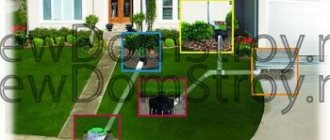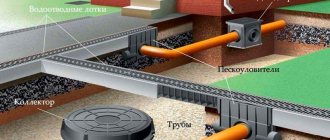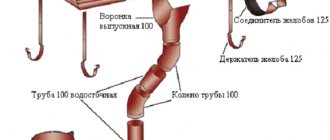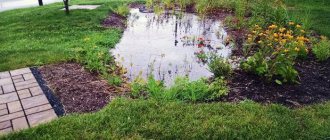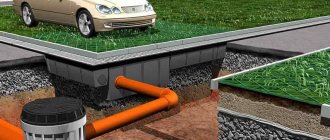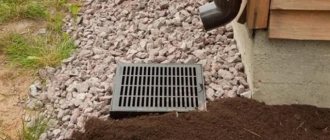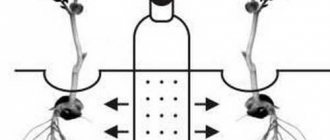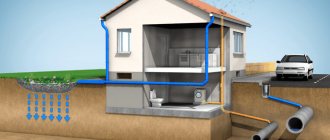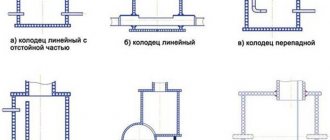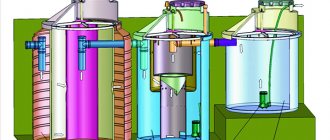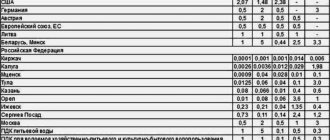A clean and dry yard after rain, no puddles on the lawn or washed-out beds, healthy plants and perfectly smooth paths are the result of proper planning and installation of surface drainage. It is difficult to achieve such a result on your own without significant expenses, but it is possible if you make storm drainage with your own hands to drain the surface and remove rainwater. In combination with a storm drain (a system for draining water from the roof), the drainage network will also reduce the amount of moisture penetrating into the deep layers of the soil - the load on the deep foundation drainage network will decrease.
Purpose of storm and drainage systems
Storm drainage or “storm drainage” serves to drain rain and melt water from the site. It is a system for collecting water from the roof into special storm water inlets with its subsequent removal from the site using external gutters or an underground pipeline.
The drainage system is designed to drain the area using drainage pipes (drains) or a drainage layer. It is carried out when groundwater is shallow and there is a risk of flooding in basements and basements. All communications are usually hidden underground to maintain an aesthetically attractive appearance of the landscape.
Both systems drain water off-site into a central catchment, natural reservoir, or drainage well. Therefore, it is advisable to organize the outlet pipeline in one trench. But pipes for drainage and storm sewerage
however, they must be different.
And all because of the seasonal overcrowding of the latter. Discharging stormwater into a drainage pipe
will disrupt the proper operation of both systems and lead to clogging of the drains.
Drainage Design Rules
The design of drainage of buildings and structures on the site is carried out on the basis of SNiP “Drainage 2.06.15-85”.
When developing a drainage design project, a plan for the location of system elements is worked out, on which pipelines and their slope angles, wells, and waste collectors are indicated. Designing a drainage system involves detailing complex elements and main components. An explanatory note is attached to the project along with an estimate for the work and required materials.
To design a drainage system in a suburban area, you will need the following initial data:
- analysis of hydrogeological and geological features of the territory;
- soil composition and characteristics;
- a detailed plan showing the outlines of all buildings on the site;
- diagrams indicating the depth of laying the foundations of buildings in section;
- location of paths and continuous paving areas on the territory being developed;
- topographic map of a personal plot, which is necessary to take into account slopes and differences in relief. Based on this information, drainage schemes for the site are designed, indicating the depth of installation of drainage pipes and other devices;
- a detailed plan of the plantings available on the site;
- layout diagram of underground utilities to prevent their damage during work.
When groundwater is located in a sandy layer on a site, systems are installed to lower its level. On clay and loamy soils with low water yield, it is customary to design local type drainage. For areas where the aquifer is located in layered soils, both general and local drainage system schemes are designed.
Features of storm drainage
Efficiency depends directly on the accuracy of determining the estimated precipitation volume. This information is available from SNiP for the source region. For small quantities, you can get by with a surface-type system, which is quite simple in design. Otherwise, installation of underground communications is necessary. In this case, stormwater and drainage are in one trench
will reduce the cost of excavation work and lay storm pipes below the freezing level of the soil, which is not usually practiced.
Elements of the storm system:
- gutters - open lines for draining water;
- storm water inlets - for point collection of water from places of organized drainage from the roof;
- grate - a filtration element that allows you to prevent large debris from entering the pipeline, and also performs a decorative function;
- sand and grease traps are special devices designed to prevent clogging of the system with sand, earth and small debris.
Types of storm drains according to the method of collecting water:
- point - is a complex network of siphon-type funnels located in places where water stagnates - organized drainage from the roof, low-lying areas, paved areas, entrance area;
- linear - involves laying gutters along the edges of paths, fences and in places where water drains unorganized from the roof.
The cost of the site drainage and storm sewer project
How much will a site drainage project cost is the question that customers first ask us; the price in this case depends on several factors:
- geological research data;
- type of drainage - surface or deep;
- area of the site.
Below are the basic prices for drainage design, but a specialist will be able to tell you the final amount only after clarifying a number of details.
| Name of service | Unit measurements | Cost, rub. |
| Preparing a drainage project | service | from 15,000 rub. |
Scheme of surface type storm drainage system
There are two ways to drain sediment: an open above-ground method and a closed underground method. With a reasonable combination, you can save a lot.
- Design stage (calculation of the slope of the gutters and expected volumes of precipitation).
- A device for draining water from the roof (installing funnels, laying external or internal drainage).
- Laying trenches up to 1 meter deep. The bottom is filled with concrete, and about 30 cm of sand and crushed stone is compacted tightly on top. In case of insignificant precipitation, you can line the walls with decorative stone and install small living fences around the perimeter of the ditches. In this case, you can refuse to use gutters.
- Laying gutters. It is safer, more reliable and more efficient to use special plastic products, through which water will not only be drained from the site, but also filtered. Subsequently, it can be used in an irrigation system. The gutters are laid in strict compliance with the calculated slope. They are mounted using couplings and sealed connections with special holes in the well.
- Testing the system under high water pressure.
- Decoration with lattice.
Features of the drainage system
The depth of groundwater can be determined using geological research. Despite the financial investment, the data obtained will make it possible to optimize the cost of purchasing material as much as possible and install drainage only in the necessary places.
Main elements of the drainage system:
- drains - perforated pipes that absorb excess groundwater and drain it, thanks to their natural slope or pump, into a drainage basin;
- inspection (inspection) wells - serve for possible cleaning of the system, its preventive maintenance and for sedimentation of earthen fractions and sand;
- rotary wells - installed at corner pipe connections (nodes) to prevent clogging;
- drainage tank - to prevent the reverse flow of waste water, drains are connected to a special tank equipped with a pump for pumping out water or a drainage bottom for drainage into the deep layers of the soil.
Types of drainage devices
- Open. It is used during the construction phase and takes the form of deep trenches dug at a certain slope.
- Backfill. This is a type of deep drainage. Performed without the use of pipes. It is a trench into which drainage is laid in layers of compacted sand, crushed stone or fine gravel, and bit bricks, and then covered with soil on top. It has a short service life of 4-7 years, after which it requires complete replacement.
- Closed. The most effective way to drain excess groundwater. When using modern materials (plastic drains) and correct calculation of volumes, the system can last more than 50 years. When combining drainage and storm sewerage,
it will also allow significant savings on earthworks.
In addition, stormwater and drainage
can discharge water into one well.
Drainage scheme for a closed area
Due to the complexity of the device and the possibility of combining the drainage system and storm sewer
It is worth considering in detail the closed type scheme:
- Design of pipe laying schemes and installation of wells. It is advisable to rely on building codes and data obtained after geological surveys.
- Digging trenches. The depth is about 1.2-2 meters and depends on the groundwater level (there should be at least a meter left to the aquifer), the depth of soil freezing, and the level of the basement floor. The laying of highways is possible both throughout the entire territory of the site and exclusively in areas of flooding. When combining drainage and storm sewer systems on a site,
the width of the trench should be increased. - Drain liner The bottom of the trench is first concreted and filled with sand. Geotextiles are laid on top, the edges of which extend out along the side walls. Next comes a layer of crushed stone (30 cm), and the pipes are laid.
- Installation of wells and hermetically sealed connection of all elements.
- Testing the system under pressure.
- Backfilling of pipes. A thick layer of crushed stone is laid on top of the drains and everything is covered with the edges of the fabric brought out. Then the soil is compacted.
- Decoration. Since the pipes are buried at a fairly large depth, crops can be planted on top or a lawn can be sown.
The main difficulties and errors in preparation for design and design:
| Main difficulties and errors. | Solutions LLC "Region" | |||||
|
| |||||
|
| |||||
|
| |||||
|
| |||||
|
| |||||
| The specificity of this engineering task - designing storm drainage networks - requires special knowledge of both current legislation, modern technologies, hydrology, hydraulic engineering and hydraulics. The qualifications of Region LLC specialists can be confirmed by many companies with which we cooperate. |
| We produce and supply equipment for treatment facilities, water supply and sewerage |
| We produce non-standard equipment in the field of water and sewerage treatment, as well as complete prefabricated installations: Sewerage
The equipment is certified on the territory of the Russian Federation. | ||
| WE WILL BE HAPPY TO ANSWER YOUR QUESTIONS |
| You can contact us from 9.00 – 18.00 (Monday – Friday). Our specialist will always answer your questions and advise on possible solutions to certain problems by phone or upon request by email [email protected] . | by number Our Skype: dc-region Our Telegram by number |
The main difficulties and mistakes in preparing for design |
| The main difficulties and mistakes when designing yourself (with your own hands) | Solutions LLC "Region" | |||||
|
| |||||
|
| |||||
|
| |||||
|
| |||||
|
| |||||
|
| |||||
| To date, Region LLC has more than 150 successfully completed survey and design works. Our customers are the largest organizations in Russia. Numerous official reviews from organizations confirm our professionalism and responsibility in working with customers. |
BIM DESIGN | |||
| We have experience in using BIM design technologies and are ready to develop a BIM project, taking into account customer requirements and technical specifications. Technological BIM design is a special art that requires extensive experience and high qualifications, which Region LLC collected bit by bit. | |||
| Models of equipment for sewage treatment facilities for industrial wastewater of a textile enterprise | |||
| General view of the model of the fluorine-containing wastewater neutralization complex | |||
| Sectional model of a sewage treatment plant building with equipment | |||
COST OF PROJECT DEVELOPMENT |
| To determine the basic (initial) cost of design estimates and survey work, Region LLC uses a time-tested method: drawing up estimates for design and survey work using reference price reference books. The estimated cost of design and survey work is a justified initial cost of work, which is clarified in the process of clarifying the scope of work and negotiations. An estimate for design and survey work compiled according to reference price reference books can serve as a justification for the price during the competitive procedure in accordance with Federal Law No. 44 and No. 223. |
| Government customers | For commercial customers | |||
| Assistance in completing applications for participation in Federal Target Programs (FTP). | We make all technical and technological decisions based on variant design and comparison of all technical and economic parameters, including operational ones. | |||
| Assistance in processing applications for funds from regional budgets (feasibility study, Justification). | Development of a feasibility study (feasibility study) of the project at the initial stages of implementation of the investment plan. | |||
| Consultations on lending from European banks and attracting grants. | Assistance in attracting credit funds for the implementation of energy service contracts (energy efficiency) and environmental projects. | |||
| Assistance in the development of investment programs. | Consulting in the field of design, design stages, design stages, approvals, necessary initial permitting documentation, etc. | |||
| Assistance in attracting credit funds for the implementation of energy service contracts (energy efficiency) and environmental projects. | ||||
BY STARTING COOPERATING WITH US YOU WILL SAVE | |
| 30% | Costs of construction and installation works. Based on alternative design and modern technologies, we select the optimal solution. 3D modeling technologies help to avoid waste of materials and minimize the likelihood of errors. |
| 25% | For the cost of design and survey work, you get a high-quality project that allows you to implement your plan on time. Thanks to an integrated approach, everything is in one hand (collection of initial data, surveys and measurements, surveys) and the experience of our specialists, we can optimize costs and offer you a competitive price. |
| 20% | Time during construction and installation work. The decisions made by our engineers and architects are not only reliable and aesthetic, but also thought out in terms of convenience and speed of implementation (flexible solutions in terms of work execution). |
As part of the design contract, we always stipulate warranty obligations and financial liability for failure to meet deadlines.
WE WILL PREPARATE ALL TECHNICAL SPECIFICATIONS | |||
| For design | For examination | For research | To develop the scheme |
Region LLC specialists are ready to provide assistance at all stages of decision-making, both at the stage of considering the project concept and when considering options for the reconstruction of existing buildings and structures. At the design preparation stage - prepare technical specifications for design and the necessary research. And also prepare estimates for design and surveys based on collections of basic prices (price justification for holding a competition).
HOW WE DESIGN | |||
| |||
LICENSES AND CERTIFICATES REGION LLC | ||||
|
|
| ||
WE WORK ON LICENSED SOFTWARE | ||||
| We design on nanoCAD - a Russian universal CAD platform containing all the necessary tools for basic design and drawing production. | Our PCs are equipped with Windows 10, an operating system for personal computers developed by Microsoft as part of the Windows NT family. After Windows 8, the system received the number 10, bypassing 9. | We work on Microsoft Office 2010 - a package of programs focused on the requirements of modern business and the needs of its employees. | ||
| The use of licensed software guarantees information security, legality of work and reduces the risks of company closure due to inspections by regulatory authorities. | ||||
| GUARANTEES FOR THE PROJECT Region LLC always assumes warranty obligations for “industrial objects”. We provide supervision and construction support and promptly resolve all issues that arise during the construction of the facility. |
| Video message from the director of Region LLC | Dear colleagues, partners, customers! One of the main activities of my company is the design of water disposal and sewerage facilities, treatment facilities and utility networks. When designing, we use advanced technologies in the field of drainage and do not impose on the customer equipment that we produce ourselves. This approach allows us to choose the optimal solution and ensure maximum efficiency of the investment and environmental project. I am always ready for constructive dialogue. I am confident that I can offer YOU the best conditions for the implementation of your project! Call +7 (812) 627-93-38 |
| Kaliningrad | Sevastopol | Rostov-on-Don |
| Moscow | Nizhny Novgorod | Novokuznetsk |
| Samara | Nizhnevartovsk | Krasnodar region |
| Khabarovsk | Krasnoyarsk | Vladivostok |
| Permian | Republic of Karelia | Armavir |
| Pskov | Arkhangelsk | Tomsk |
| Volgograd | Tyumen | Ulan-Ude |
| Novosibirsk | Kazan | Ekaterinburg |
| Lipetsk | Chelyabinsk | Ufa |
| Kaluga | Slavyansk-on-Kuban | Petrozavodsk |
| Orenburg | Bratsk | Irkutsk |
| Monchegorsk | Ust-Ilimsk |
We are engaged in complex design throughout Russia and are looking for representatives in Murmansk, Vologda, Syktyvkar, Omsk, Voronezh and other Russian cities.
We see all participants in the construction market as our partners and are ready for long-term mutually beneficial cooperation with suppliers, manufacturers of equipment and materials, builders, developers, developers and manufacturing enterprises, and even with design organizations we build honest partnerships.
Combination of storm and drainage system
The drainage network drains water through pipes into a storage or drainage well. The stormwater system first involves the entry of water from all collected surfaces into the collector, and from there, through its own pipe line ( drainage and stormwater in one pipe
not permissible!) is sent to the well. The well is equipped with an electric pump and automatically pumps water into the central sewer system, natural reservoir or irrigation system.
A device for drainage and removal of rainwater is an important element in preserving buildings and the site itself from the harmful effects of excess moisture. The main thing is to plan and design systems in a timely manner, which will also allow you to save significantly.
